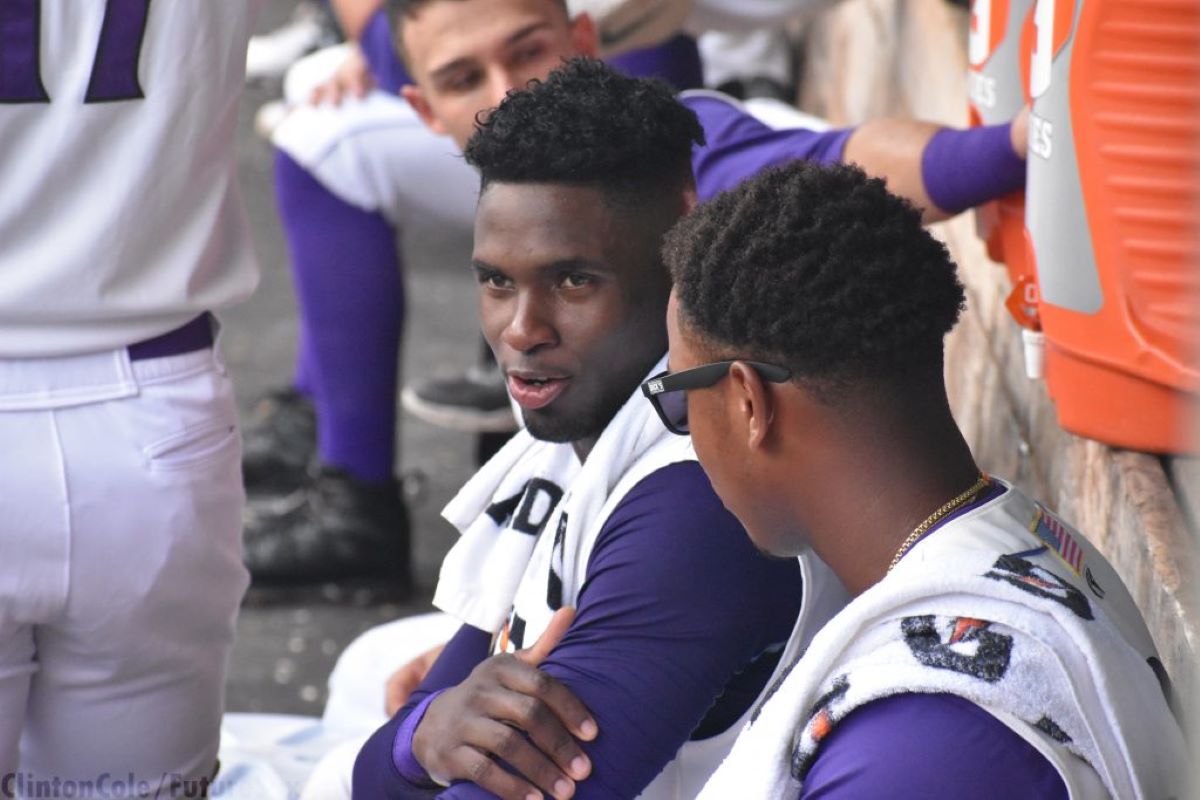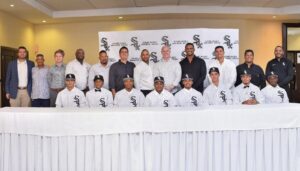2019-2020 White Sox International Review

via Clinton Cole
The 2020 international signing period ended on October 15 and it was an unusual year for prospects, scouts and everyone else involved. 1,022 players signed in all, according to Jesse Sanchez of MLB.com. The signing period was originally scheduled to end on June 15, 2020 with the upcoming 2021 period starting on July 2 of this year. The Covid-19 pandemic pushed back the 2020-2021 scouting period to the beginning of 2021. In turn, the current period was extended into October.
Over 30 prospects were signed during the final week of this period and many of those players would’ve been forced to wait until the next period otherwise. International scouting was halted during the pandemic with many countries having lockdowns in place. Scouting has since re-opened with some obvious restrictions in place. The Pittsburgh Pirates spent a total of $8,488,700 and signed Taiwanese righty Po-Yu Chen for $1.25 million in October.
The 2020-2021 signing period that was originally slated to begin this past July will start on January 15, 2021. That period will run through December 15, 2021. The majority of clubs have most of their money committed to prospects in this period already and international budgets have been allocated for the most part. Without the ability to trade away international bonus pool space in the next two periods, some teams might be in a bind in regards to reported agreements. Some international amateurs who become available during the middle of the next period could be in a tough spot with the 2021-2022 signing period not scheduled to begin until January 2022.
White Sox Signings
The Chicago White Sox started the international period with $5,398,300 to spend on the international market. It’s a finite resource in the sense that the club is spending its own cash, but they’re limited in the amount that they can spend. Opportunity was there for the organization to potentially acquire the right to spend up to 75% more of their own money, but the franchise didn’t acquire anymore pool space. Instead, they spent $3,905,000 on 17 players from Cuba, Venezuela and the Dominican Republic.
The biggest signing in their class was Cuban shortstop Yolbert Sanchez. The infielder is the 17th ranked prospect in the system according to our midseason update. Lauded for his glove, Yolbert played in 29 games in the Dominican Summer League last year. He signed for $2.5 million on July 2, 2019 after defecting from Cuba in late 2018. The 23-year-old posted a .297/.386/.441 slash line in the DSL. Sanchez displayed stellar glove work at shortstop and also walked almost 12% of the time. He hit two homers, drove in 12 and posted a 130 wRC+ as well. The problem is that his upside is limited due to his age and hitting profile.
The shortened season really hurt Sanchez because he was slated to play in Low-A with the Kannapolis Cannon Ballers. He missed an entire season and he’s already 23 years old without having played any stateside baseball to date. Currently, Sanchez is participating in instructional league action with the White Sox’s club in Arizona. Swing changes could be on the horizon and the organization believes in Sanchez more than the industry consensus to date. Marco Paddy has made calls like this before and he’s often correct. The 5-foot-11, 175-pounder will likely play at one level of A ball in 2021.
19-year-old Elijah Tatis, the younger brother of Fernando Tatis Jr., signed for $400,000 during last year’s period. Elijah struggled in 25 games in the Dominican Summer League but did post a 14.4% walk rate. He made our just missed list of prospects during the midseason rankings.
Tatis has a strong and accurate arm and he should be able to stay at shortstop long-term. The ball jumps off his bat and he shows a simple, repeatable swing and a good eye at the dish. Adding significant strength is a priority for Tatis, as well as the organization, and that is well underway according to reports. Tatis should make his stateside debut in Arizona in 2021.
Cristian Mena was the top pitcher in the White Sox class. He signed for $250,000 out of the Dominican Republic. The 16-year-old has been relegated to Tricky League action to this point, but Baseball America’s Ben Badler raved about the young right-hander on an episode of the FutureSox podcast. Mena is 6-foot-2 and 170 pounds and possesses an easy delivery and a feel for three pitches.
Mena shows starter traits with an athletic and projectable body. His fastball already touches 91 mph and he pairs it with a high spin rate breaking ball that has the look of a potential out pitch. Mena likely throws in the Dominican Summer League for the White Sox in 2021. He is a name to watch going forward.
Wilfred Veras is the cousin of Elijah Tatis and he has more bloodlines as well. His father Wilton is a former big leaguer in addition to the ties to the Tatis family. The third baseman signed for $200,000 out of the Dominican Republic and the White Sox were attracted to his power potential from the right side according to Badler. The 6-foot-2, 180-pounder has already shown middle-of-the-field power and has physical upside. The 17-year-old is a below average runner but should stay at the hot corner. Veras has a strong arm, good hands and solid footwork and he is likely to play in the Dominican Summer League in 2021.
The White Sox signed 17 players in all and they’re listed below.
Name Position (Country, Age)
Yolbert Sanchez INF (Cuba, 23)
Elijah Tatis INF (DR, 19)
Wilfred Veras INF (DR, 17)
Cristian Mena RHP (DR, 17)
Erick Bello RHP (DR, 18)
Richard Aguilar C (Ven., 17)
Emerson Talavera RHP (Ven., 18)
Randel Mondesi OF (DR, 17)
Arxy Hernandez INF (DR, 17)
Yohemy Nolasco RHP (DR, 17)
Javier Mora INF (Ven., 17)
Keiter Perez RHP (DR, 19)
Brian Carrion RHP (DR, 21)
Alvaro Aguero CF (DR, 17)
Layant Tapia SS
Carlos Gomez OF
Luis Valenzuela SS
Dollars and Sense
The White Sox have converted on some significant high profile, impactful international signings in recent years. Marco Paddy is one the of the best international scouts in baseball. He’s responsible for scouting and delivering Jose Abreu, Fernando Tatis Jr. and Luis Robert.
Abreu is the front runner for the American League Most Valuable Player award. Tatis Jr. is a candidate for the same distinction in the National League. Robert is a Rookie of the Year contender in the AL as well. The White Sox are often credited for their work on the international market, but far too often they fail to take advantage of one of the greatest assets they currently possess.
The organization has always favored an approach that lends itself to quantity over quality. When a guy like Paddy is employed, this sort of strategy will work out occasionally. Jerry Reinsdorf doesn’t value 16-year-old talent and therefore his organization doesn’t compete in that marketplace.
$1.5 million is the largest single outlay given to a player in this age group in this marketplace by the organization. The rest of the industry places a premium on accessing this talent stream regardless of the seedy nature of the business side of such transactions. The international marketplace is a blind spot for most observers and even some media members that cover the team full-time. With Robert patrolling center field, it’s easy to assume that the White Sox are ahead of the game in regards to signing international amateurs.
Their overall strategy leaves a lot to be desired, though. During the 2019-2020 international period, the White Sox spent $3,905,000. That was the least amount of money spent by any team in the market this year other than the Atlanta Braves, who were forced to sit out the signing period. Within the Al Central, every club spent more money on the international market than the White Sox did and they reside in the third largest market in the sport.
The Cleveland Indians spent $4.9 million on international amateurs. The Detroit Tigers and Minnesota Twins spent $5.3 million and $5.9 million, respectively. The Kansas City Royals spent a total allotment of $6,319,500. There is no excuse for the White Sox to not spend the full allocated amount of money on the international market in a given year. An argument can even be made that they should be acquiring more pool space to allow Paddy to work.
What happened to the rest of the money that was allocated to the White Sox in the previous signing period? It was used to save ownership actual money in a pair of the most short-sighted transactions of the past year. In July 2019, the White Sox traded Nate Jones to the Texas Rangers along with $1 million of international space in exchange for two fringe pitching prospects.
The point of this transaction was simple, albeit frustratingly dense. The franchise forfeited the chance to spend an additional $1 million of their own finite resources on the international front in exchange for Texas paying Jones’ buyout for them. The frugality didn’t stop there, however. In November, Jon Daniels of the Rangers came calling again and the White Sox decided to oblige.
Texas acquired catcher Welington Castillo from the White Sox along with another $250,000 in international pool space in exchange for a minor leaguer who is no longer in affiliated baseball. Trading fake money to save real money was a new low point in the Reinsdorfian business model and it still has effects to this day.
Treating a Major League Baseball club like a mom and pop operation is pennywise and pound foolish. Instead of making these trades, the White Sox could have just released Jones and Castillo and paid the buyouts that were agreed to in the signed contracts in the first place. Had they done this, they would have an extra $1.25 million laying around to sign international free agents.
The company line has been that the deals were shrewd decisions made by general manager Rick Hahn due to the club not having agreements in place with additional available prospects. That’s actually the biggest problem.
Paddy is a tremendous asset and one of the very best in the business and there’s no possible way that he couldn’t find players that the organization could benefit from. It was just a matter of robbing Peter to pay Paul. This directly relates to a quad of Cubans that are currently available in the market as well.
The 2020-2021 international period was pushed back to January 15 and the White Sox are expected to be active. FutureSox reported on six signings from the Dominican Republic and Venezuela that will become official on that date. The organization is also expected to sign 20-year-old Cuban right-hander Norge Vera in January as well. With an allotted pool of $5,398,300 and no ability to trade for more space, the club might have some tough decisions ahead. The White Sox have around $3.2 million already committed to the seven prospects noted for the upcoming period, leaving them with somewhere in the neighborhood of $2.2 million to play with.
High profile Cuban outfielders Yoelquis Cespedes and Oscar Colas should both be available and neither has a current commitment. 16-year-old Cuban outfielder Mario Luis Pino is another player in whom the White Sox have shown some level of interest. Vera, Cespedes and Pino were all eligible to sign during this current period but all will be waiting until January.
The Sox have reportedly shown heavy interest in Colas and Cespedes, but it’s unlikely that they could land both players with the $2.2 million remaining in their pool. Colas isn’t cleared to sign a contract yet, but it’s unlikely that he’d wait until January 2022 to sign his first big league contract.
The White Sox should sign a really solid international class during the upcoming period. It could be even better if they hadn’t cut off their noses to spite their face with those earlier deals though. In theory, Norge Vera’s deal ($1.5 million) could have slotted nicely into the previous period and he could be pitching in fall instructs right now instead of working out in the Dominican Republic on his own.
The White Sox would then have close to $4 million available to attack deals with Cespedes, Colas and Pino in the next period. Instead, Vera will be a member of that signing class and the Sox will have to decide which one of the Cuban outfielders to prioritize.
When the White Sox traded international pool space to save money on contract buyouts, it didn’t make sense. They weren’t aware that a global pandemic would change the trajectory of international free agency and turn the industry on its head. It happened, though, and the White Sox are in a worse position than they would have been otherwise due to making those puzzling transactions.
With a push toward contention in the big leagues, the club will be drafting later in each round. One area where they can make up for lost time is in the international marketplace. They employ one of the very best in the business for a reason. It’s time for the organization to stay out of the man’s way.
Photo credit: Clinton Cole/FutureSox
Want to know right away when we publish a new article? Type your email address in the box on the right-side bar (or at the bottom on a mobile device) and click create subscription. Our list is completely spam free, and you can opt out at any time. Also, consider supporting FutureSox on Patreon! You can get early access to special articles and Patreon-only posts, in addition to more benefits.
Shop our exclusive merchandise! Show your support with FutureSox apparel.







Of course there are other ways to improve your organization aside from the international and domestic amateur markets which have monetary caps in place. Shrewd trades and MLB free agency are also available and have had an impact on the White Sox big league roster and their number of top prospects in recent years. The White Sox have also been the most pro-active of all MLB teams in offering contract extensions to their pre-arbitration players including two in Eloy Jimenez and Luis Robert before they even made their MLB debuts. All one needs to do is look to the other side of town where the other Chicago baseball team has many of their core players reaching free agency following the 2021 season.